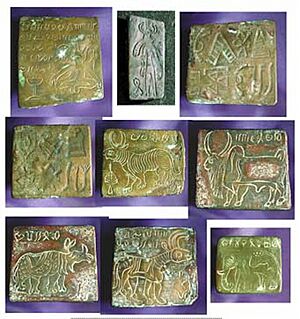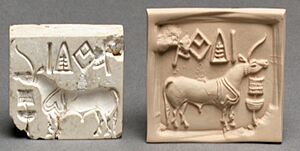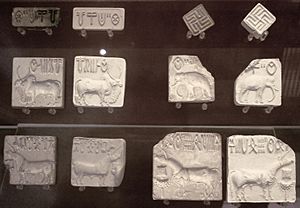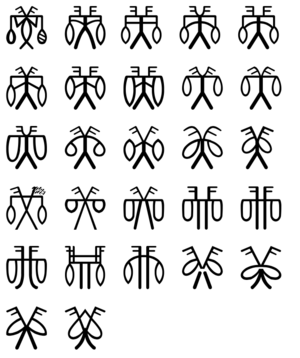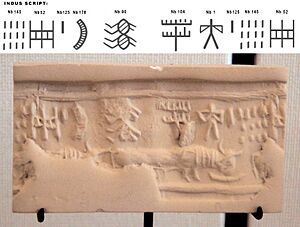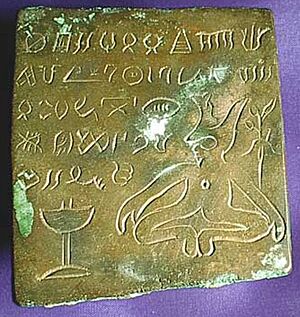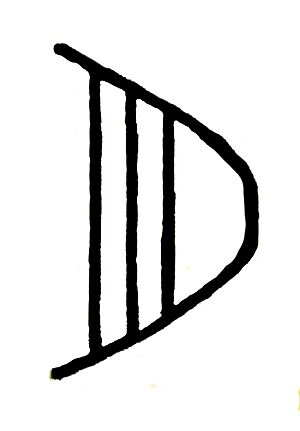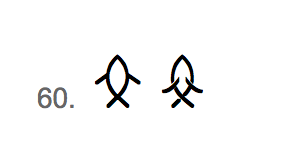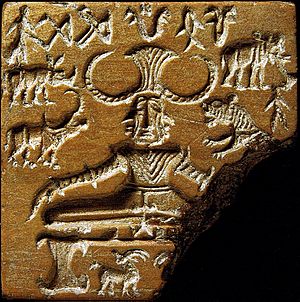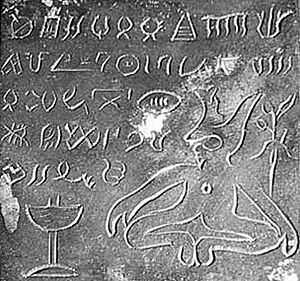Indus script facts for kids
Quick facts for kids Indus script |
|
|---|---|

Seal impression showing a typical inscription of five characters
|
|
| Type | Undeciphered possibly Bronze Age writing or proto-writing |
| Spoken languages | Unknown (see Harappan language) |
| Time period | c. 3500–1900 BCE |
| ISO 15924 | Inds |
| Note: This page may contain IPA phonetic symbols in Unicode. | |
The Indus script, also called the Harappan script, is a collection of mysterious symbols. People from the Indus Valley Civilisation used these symbols a very long time ago. Most of these writings are super short, which makes it hard to know if they were a real writing system or just simple marks. We still don't know what language they might have written.
Even though many smart people have tried, nobody has figured out what the Indus script means. There's no "Rosetta Stone" (a text written in two languages) to help us. The symbols didn't change much over time, but how they were put together sometimes changed depending on the place.
Contents
Discovering the Indus Script
The first time anyone saw these symbols was in 1875. A drawing of a seal with Harappan symbols was published by Alexander Cunningham. By 1992, about 4,000 objects with these symbols had been found. Some were even found far away in Mesopotamia, showing that the Indus people traded with them. There are over 400 different signs in all the known writings.
Some experts think the later Brahmi script might be connected to the Indus system. Others believe the Indus symbols might be linked to ancient megalithic graffiti symbols found in India and Sri Lanka. These symbols probably weren't a full language, but they might share some signs with the Indus script. Many linguists, like Iravatham Mahadevan and Asko Parpola, believe the script is related to a Dravidian language.
Where We Find the Symbols

By 1977, over 2,900 objects with clear Indus script had been found. By 1992, this number grew to about 4,000. These symbols are mostly found on stamp seals, pottery, bronze, and copper plates. They are also on tools and weapons. Most of the writings are on seals, copies of seals, or marks on pottery.
The seals and their copies were usually small, only about 2–3 centimeters on each side. We haven't found any Indus script on things that rot easily, like paper, cloth, or wood.
Early Harappan Period
The earliest examples of the Indus script appeared around 2800–2600 BCE. This was during the Early Harappan period. They were found on pottery and clay copies of seals. These symbols started appearing with other important items like seals and standardized weights. However, digs at Harappa show that some symbols developed from simple marks made by potters even earlier, around 3500–2800 BCE.
Mature Harappan Period
During the Mature Harappan period, from about 2600–1900 BCE, we find many strings of Indus signs. They are often on flat, rectangular stamp seals. They are also written or carved on many other things like pottery, tools, tablets, and jewelry. The signs were made by carving, chiseling, pressing, or painting. They were put on materials like clay, sandstone, soapstone, bone, shell, copper, silver, and gold.
As of 1977, most (about 90%) of the Indus script seals and objects were found in Pakistan. These sites are along the Indus River and its branches, like Mohenjo-daro and Harappa. The other 10% were found elsewhere. Often, animals like bulls, elephants, rhinoceros, and a mythical "unicorn" were shown with the text on seals. This might have helped people who couldn't read know where a seal came from.
Late Harappan Period
The Late Harappan period, from about 1900–1300 BCE, came after the busy Mature Harappan period. This was a time when the civilization started to break apart. The use of the script mostly stopped at Harappa around 1900 BCE. However, the Indus script might have lasted longer in other places, like Rangpur, Gujarat, especially as marks on pottery.
Seals from the Jhukar Phase of the Late Harappan period (in modern Sindh, Pakistan) don't have the Indus script. But some pottery pieces from this time do have marks. Both seals and pottery with Indus script, dated around 2200–1600 BCE, have been found at sites linked to the Daimabad culture in modern Maharashtra.
After the Harappan Period
Many items, especially pottery pieces and tools, have been found with markings. These were found in Central India, South India, and Sri Lanka. They date to the Megalithic Iron Age, which came after the Late Harappan period. These marks include writings in the Brahmi and Tamil-Brahmi scripts. But they also have other Megalithic graffiti symbols that existed at the same time.
Just like with the Indus script, experts don't agree on what these non-Brahmi symbols mean. Some, like Gregory Possehl, think these symbols are a continuation of the Indus script. In 1960, archaeologist B. B. Lal found that many of the megalithic symbols were the same as Indus script symbols. He thought this showed a shared culture between the Indus Valley Civilisation and the later Megalithic period.
What the Symbols Look Like
The characters often look like pictures of things from the ancient world, or things found in the Harappan culture and nature. But there are also many abstract signs. Some signs are made up of simpler picture signs. Others are only seen as parts of bigger, more complex signs. Some signs look like tally marks and are often thought to be early numbers.
How Many Signs Are There?
There are over 400 main signs. This is considered too many for each sign to be just a sound. So, experts generally think the script is logo-syllabic, meaning signs can represent whole words or syllables. The exact number of signs is not certain because experts disagree on whether some signs are truly different or just variations of the same sign.
In the 1970s, Iravatham Mahadevan listed 419 different signs. However, in 2015, Bryan Wells estimated there were around 694 distinct signs. Out of Mahadevan's signs, 113 appear only once. Only 67 signs make up 80 percent of all the symbols used. The most common sign is the "jar" sign.
How Was It Written?
Most experts agree that the Indus script was usually read from right to left. However, some examples show it was written from left to right, or even in a boustrophedon style (changing direction each line, like an ox plowing a field). We know the writing direction even though we can't read it. This is because the symbols are sometimes squished on the left side, as if the writer was running out of space. On seals, which make a mirror image, the impression is read from right to left.
Is It Related to Other Scripts?
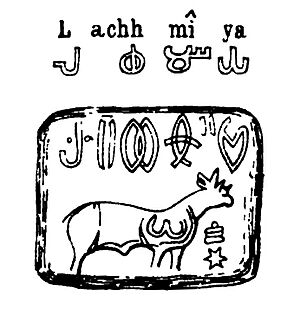
Some researchers have tried to connect the Indus script to Brahmi, saying it might be an ancestor to later writing systems in India. Others have compared it to similar picture-based scripts from Mesopotamia and Iran, like early Sumerian and Elamite scripts. However, most researchers now agree that the Indus script is not closely related to any other writing systems from that time. A clear link between the Indus script and any other script has not been proven.
Comparing with Brahmi
Researchers have looked at the Indus Valley script and the Brahmi and Tamil-Brahmi scripts. They suggest there might be similarities. These ideas were first brought up by early European scholars. Some, like G. R. Hunter, thought Brahmi might have come from the Indus script.
Comparing with Proto-Elamite
Researchers have also compared the Indus Valley script with the Proto-Elamite script. This script was used in Elam, an ancient civilization that existed at the same time as the Indus Valley civilization. Both scripts used many pictures. About 35 Proto-Elamite signs might be similar to Indus signs.
Trying to Solve the Mystery
It's very hard to figure out what the Indus script means. Here are the main reasons why:
- Short writings: Most writings are very short, usually around five signs. The longest one found is only 34 characters long.
- Is it even a language? Some wonder if the Indus script is a real written language. It might just be a system of non-language signs, like merchant's marks or symbols for families.
- Unknown language: We don't know what language the Harappan people spoke. So, even if it is a written language, we don't know what language it represents.
- No "Rosetta Stone": There are no texts written in two languages, like the famous Rosetta Stone, to help us translate.
- No known names: We don't know the names of any Indus rulers or important people from other historical records. This makes it hard to guess what certain signs might mean.
Many different ideas for deciphering the script have been suggested, but no one has agreed on a solution. The few things experts do agree on are:
- Most writings go from right to left.
- Some stroke-like signs are numbers.
- Certain signs at the end of inscriptions have similar uses.
- They have ways to divide the writings into groups of signs.
Over 100 different attempts to decipher the script have been published since the 1920s. It's a popular topic for people who love puzzles!
Is It a Dravidian Language?
Some experts believe the Indus script recorded a Dravidian language. Early supporters included Henry Heras, who tried to read signs based on this idea.
Based on computer analysis, Russian scholar Yuri Knorozov thought a Dravidian language was the most likely candidate. The Finnish scholar Asko Parpola also used computers to study the script. He also concluded that the Indus script and Harappan language "most likely belonged to the Dravidian family."
These scholars have suggested meanings for many signs. One interesting idea connects the Dravidian word mīn, which means both 'fish' and 'star'. This connection was hinted at by drawings of both fish and stars together on some Harappan seals. In 2011, Rajesh P. N. Rao said that while the proposed readings make sense, they aren't yet proven.
In 2014, Iravatham Mahadevan found a repeating sequence of four signs. He thought it was an early Dravidian phrase meaning "Merchant of the City." He said he hadn't fully deciphered the script, but he felt he had proven it was a Dravidian written language.
Other Language Ideas
Indo-Aryan Language
One idea is that the Indus script records an early Indo-Aryan language. The Indian archaeologist Shikaripura Ranganatha Rao claimed he had deciphered the script. He thought the later Phoenician alphabet came from the Harappan script. He read the script from left to right and believed it included numbers and was in Sanskritic (an old form of Sanskrit).
However, there are many problems with this idea. For example, horses were very important in Indo-European cultures, but not in the Indus Valley Civilization. Also, the Indus script doesn't seem to have the word endings or prefixes that Indo-European languages like Sanskrit have.
Munda Language
Another less popular idea is that the Indus script belongs to the Munda family of languages. These languages are spoken mostly in central and eastern India. However, like the Indo-Aryan idea, the known words of early Munda don't seem to match the Harappan culture.
Not a Language at All?
Some experts believe these symbols are not a language at all. They think the symbols might represent families, clans, gods, or religious ideas, similar to symbols on coats of arms or totem poles. In 2004, Steve Farmer, Richard Sproat, and Michael Witzel argued that the Indus script is not a language. Their main reasons are:
- The writings are extremely short.
- There are too many rare signs that appear only a few times.
- The signs don't repeat in the random way that is typical of real languages.
The Fish Sign Mystery
One interesting idea is called the "image puzzle theory." It suggests that an Indus script picture might have a hidden sound meaning. To figure this out, you look for times when the picture and its intended meaning sound the same in the language.
We know Indus inscriptions are mostly on seal stones used for trade. These seals were used like those in ancient West Asia, where they often had names of gods. So, Indus seals likely had names and titles too. If the "fish" sign in the Indus script meant "god," it would be a clue. Finding a language where "fish" and "god" sound alike would help prove this theory.
Indus Script in Computers
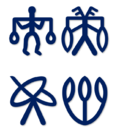 |
|
| Designer(s) | National Fund for Mohenjo-daro |
|---|---|
| Date created | 2016 |
| Date released | 2017 |
| License | Proprietary |
The Indus symbols have a special code called "Inds" for computer use (ISO 15924). A proposal was made in 1999 to add the script to Unicode (a system for computer text), but it hasn't been approved yet.
There is a special computer font called "Indus Script Font." It was made based on a collection of signs put together by Asko Parpola. This font was created by Amar Fayaz Buriro and Shabir Kumbhar for the National Fund for Mohenjo-daro. They showed it at a conference in 2017.
What Happened to the Script?
The Indus Valley Civilization began to decline around 1800 BCE. As the civilization faded, so did its writing system. The Vedic civilization, which came later in North India, did not use the Indus Script and didn't have its own writing system for many centuries. India had to wait almost a thousand years for writing to appear again.
See also
- Related topics
- Early Indian epigraphy
- Lipi (script)
- Meluhha
- Outline of ancient India
- Sindhology
- History
- History of ancient numeral systems
- History of India
- History of Pakistan
- History of writing
- List of languages by first written accounts
- Other similar topics
- Anaikoddai seal
- Edicts of Ashoka
- Protohistory
- South Indian Inscriptions
- Undeciphered writing systems


